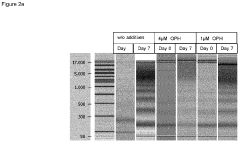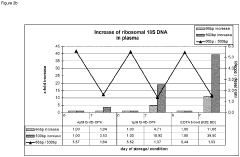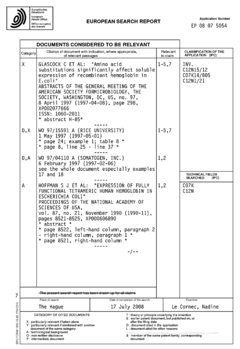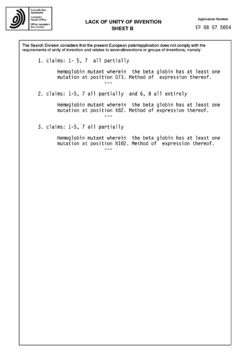Understanding Hypertonic Effects on Human Cells
Hypertonic Effects Background and Objectives
The study of hypertonic effects on human cells has been a crucial area of research in cellular biology and physiology for decades. This field explores the impact of solutions with higher solute concentrations than those found within cells, leading to various cellular responses and adaptations. The historical context of this research dates back to the early 20th century when scientists first began to investigate osmotic pressure and its effects on living organisms.
As our understanding of cell biology has advanced, so too has our knowledge of hypertonic effects. These effects play significant roles in numerous physiological processes and pathological conditions, ranging from cellular volume regulation to the development of certain diseases. The evolution of this field has been marked by key discoveries in membrane transport, signaling pathways, and cellular stress responses.
The primary objective of studying hypertonic effects on human cells is to elucidate the mechanisms by which cells respond to osmotic stress and maintain homeostasis. This includes understanding how cells detect changes in osmolarity, the signaling cascades that are activated, and the various adaptive responses that cells employ to survive in hypertonic environments. Additionally, researchers aim to uncover the potential therapeutic applications of manipulating these cellular responses.
Current research in this field focuses on several key areas. One major focus is the investigation of ion channels and transporters that are involved in cell volume regulation under hypertonic conditions. Another important area of study is the role of osmolytes, organic compounds that cells accumulate to counteract the effects of hypertonicity. Furthermore, researchers are exploring the cellular stress responses triggered by hypertonic environments, including the activation of heat shock proteins and other protective mechanisms.
The implications of this research extend far beyond basic cellular biology. Understanding hypertonic effects is crucial for developing treatments for various medical conditions, such as cystic fibrosis, where abnormal ion transport leads to hypertonic mucus secretions. It also has applications in the field of cryopreservation, where cells must be protected from the damaging effects of hypertonic solutions during freezing and thawing processes.
As technology advances, new tools and techniques are being employed to study hypertonic effects at increasingly detailed levels. High-resolution imaging, single-cell analysis, and advanced molecular biology techniques are providing unprecedented insights into the cellular responses to hypertonic stress. These technological advancements are expected to drive further progress in the field, potentially leading to novel therapeutic strategies and a deeper understanding of cellular physiology.
Market Analysis for Hypertonic Solutions
The market for hypertonic solutions is experiencing significant growth, driven by increasing applications in medical treatments, research, and biotechnology. The global hypertonic solutions market is projected to expand at a steady rate over the next five years, with a particular focus on healthcare and pharmaceutical sectors. This growth is primarily attributed to the rising prevalence of chronic diseases, advancements in cell therapy research, and the expanding use of hypertonic solutions in wound care management.
In the healthcare sector, hypertonic solutions are widely used in various medical applications, including the treatment of edema, intracranial pressure management, and as a component in intravenous therapies. The increasing incidence of traumatic brain injuries and the growing aging population contribute to the demand for hypertonic saline solutions in neurological treatments. Additionally, the use of hypertonic solutions in perioperative fluid management has gained traction, further boosting market growth.
The biotechnology and research segments are also key drivers of market demand. As cell culture techniques advance and the field of regenerative medicine expands, the need for specialized hypertonic solutions for cell preservation and manipulation has increased. This trend is particularly evident in stem cell research and cryopreservation applications, where maintaining cellular integrity is crucial.
Geographically, North America and Europe currently dominate the hypertonic solutions market, owing to their advanced healthcare infrastructure and significant investments in medical research. However, the Asia-Pacific region is expected to witness the fastest growth in the coming years, driven by improving healthcare access, increasing research activities, and rising awareness about advanced medical treatments.
The market landscape is characterized by a mix of established pharmaceutical companies and specialized biotechnology firms. Key players are focusing on product innovation, particularly in developing tailored hypertonic solutions for specific medical conditions and research applications. There is also a growing emphasis on the development of ready-to-use formulations and improved packaging to enhance convenience and reduce the risk of contamination.
Challenges in the market include regulatory hurdles, particularly for novel formulations, and the need for extensive clinical validation of new applications. Additionally, the potential side effects associated with the use of hypertonic solutions in certain patient populations necessitate careful consideration and ongoing research to optimize safety profiles.
Current Challenges in Hypertonic Research
Despite significant advancements in hypertonic research, several challenges persist in understanding the full spectrum of hypertonic effects on human cells. One of the primary obstacles is the complexity of cellular responses to hypertonic stress, which can vary significantly depending on cell type, duration of exposure, and the degree of hypertonicity. This variability makes it difficult to establish universal models or predictions for cellular behavior under hypertonic conditions.
Another major challenge lies in accurately measuring and monitoring intracellular changes during hypertonic stress. While techniques such as fluorescence microscopy and electrophysiology have provided valuable insights, they often fall short in capturing real-time, dynamic changes within cells without disrupting cellular processes. This limitation hinders our ability to fully understand the temporal sequence of events that occur during hypertonic stress and recovery.
The long-term effects of chronic hypertonic exposure on human cells remain poorly understood. Most studies focus on acute responses, but the cumulative impact of prolonged or repeated hypertonic stress on cellular function, gene expression, and overall tissue health is not well-characterized. This gap in knowledge is particularly relevant for conditions such as diabetes, where cells may be exposed to hypertonicity over extended periods.
Researchers also face difficulties in isolating the specific effects of hypertonicity from other concurrent cellular stresses. In many physiological and pathological conditions, hypertonic stress occurs alongside other factors such as oxidative stress, inflammation, or nutrient deprivation. Disentangling the unique contributions of hypertonicity to cellular dysfunction in these complex environments presents a significant challenge.
The translation of in vitro findings to in vivo systems and, ultimately, to clinical applications remains a substantial hurdle. The controlled environment of laboratory studies often fails to capture the full complexity of living organisms, where multiple systems interact and compensate for one another. Developing animal models that accurately reflect human responses to hypertonic stress is crucial for advancing our understanding and developing therapeutic interventions.
Furthermore, there is a need for standardization in hypertonic research methodologies. Variations in experimental protocols, cell culture conditions, and measurement techniques make it difficult to compare results across different studies. Establishing consensus guidelines for hypertonic research could greatly enhance the reproducibility and reliability of findings in this field.
Lastly, the molecular mechanisms underlying cell volume regulation and adaptation to hypertonic stress are not fully elucidated. While key players such as ion channels and transporters have been identified, the intricate signaling networks and feedback mechanisms that orchestrate these responses remain to be fully mapped out. Unraveling these complex pathways is essential for developing targeted therapies to mitigate the harmful effects of hypertonic stress on human cells.
Current Methodologies for Hypertonic Research
01 Hypertonic effects on cell volume regulation
Hypertonic conditions cause water to move out of cells, leading to cell shrinkage. This triggers various cellular mechanisms to regulate volume, including the activation of ion channels and transporters to restore osmotic balance. Understanding these processes is crucial for developing treatments for conditions involving osmotic stress.- Hypertonic effects on cell volume regulation: Hypertonic conditions cause water to move out of cells, leading to cell shrinkage. This triggers various cellular mechanisms to regulate volume, including the activation of ion channels and transporters to restore osmotic balance. Understanding these processes is crucial for developing treatments for conditions involving osmotic stress.
- Impact of hypertonic stress on cell metabolism: Hypertonic environments can significantly alter cellular metabolism. This includes changes in enzyme activity, protein synthesis, and energy production. Studying these metabolic shifts can provide insights into cell adaptation mechanisms and potential therapeutic targets for osmotic stress-related disorders.
- Hypertonic effects on cell signaling pathways: Exposure to hypertonic conditions activates various signaling cascades in human cells. These pathways can influence gene expression, cell cycle progression, and stress responses. Elucidating these signaling mechanisms is important for understanding cellular adaptation to osmotic stress and developing targeted interventions.
- Hypertonic-induced changes in cell membrane properties: Hypertonic environments can alter cell membrane structure and function. This includes changes in membrane fluidity, permeability, and the organization of membrane proteins. Understanding these alterations is crucial for developing strategies to protect cells from osmotic damage and improve their survival under hypertonic stress.
- Applications of hypertonic effects in biotechnology and medicine: The understanding of hypertonic effects on human cells has led to various applications in biotechnology and medicine. These include the development of preservation techniques for cells and tissues, osmotherapy for certain medical conditions, and the design of drug delivery systems that exploit cellular responses to osmotic stress.
02 Impact of hypertonic stress on cellular metabolism
Hypertonic environments can significantly alter cellular metabolism. This includes changes in energy production, protein synthesis, and gene expression. Cells may adapt by accumulating compatible osmolytes or modifying their metabolic pathways to cope with the stress. These adaptations have implications for cell survival and function under osmotic pressure.Expand Specific Solutions03 Hypertonic solutions in medical applications
Hypertonic solutions have various medical applications, including treatments for edema, increased intracranial pressure, and certain types of shock. These solutions can be used to draw water out of tissues or cells for therapeutic purposes. Understanding the cellular response to hypertonic conditions is crucial for optimizing these treatments and minimizing potential side effects.Expand Specific Solutions04 Cellular signaling pathways activated by hypertonic stress
Hypertonic stress activates specific cellular signaling pathways that help cells adapt to osmotic changes. These pathways can involve MAP kinases, transcription factors, and other signaling molecules. Elucidating these pathways provides insights into cell stress responses and potential targets for interventions in osmotic stress-related disorders.Expand Specific Solutions05 Hypertonic effects on cell membrane and cytoskeleton
Hypertonic conditions can cause significant changes to the cell membrane and cytoskeleton. This includes alterations in membrane fluidity, protein organization, and cytoskeletal structure. These changes can affect cellular functions such as transport, signaling, and mechanical properties. Understanding these effects is important for developing strategies to protect cells from osmotic damage.Expand Specific Solutions
Key Players in Hypertonic Studies
The field of understanding hypertonic effects on human cells is in a mature stage of development, with a substantial market size driven by applications in medicine, biotechnology, and research. The technology's maturity is evident from the involvement of diverse players, including academic institutions like Nanjing University of Chinese Medicine and Duke University, as well as industry leaders such as Sana Biotechnology and Exelixis. The competitive landscape is characterized by a mix of pharmaceutical companies, medical device manufacturers, and research organizations, indicating a broad range of applications and ongoing innovation. Companies like Medtronic and Baxter Biotech Technology SARL contribute to the technological advancement, while research institutions continue to push the boundaries of scientific understanding in this field.
Sana Biotechnology, Inc.
Medtronic, Inc.
Breakthrough Studies on Hypertonic Effects
- A method involving the use of apoptosis inhibitors, hypertonic agents, and specific compounds to stabilize extracellular nucleic acids, preventing contamination and degradation, allowing for storage at room temperature for extended periods without compromising sample quality.
- Introducing specific mutations into the beta and alpha subunits of recombinant hemoglobin, such as D73I, D73M, and E11(Val→Leu), along with the addition of excess hemin, to enhance soluble expression and reduce the rate of nitric oxide scavenging by modifying the heme pocket residues, thereby altering the reaction kinetics with nitric oxide.
Regulatory Framework for Hypertonic Studies
The regulatory framework for hypertonic studies is a critical aspect of research and clinical applications involving the effects of hypertonic solutions on human cells. This framework encompasses a range of guidelines, standards, and legal requirements that govern the conduct of such studies, ensuring the safety of participants and the validity of research outcomes.
At the international level, organizations such as the World Health Organization (WHO) and the International Conference on Harmonisation (ICH) provide overarching guidelines for biomedical research. These guidelines often serve as a foundation for national regulatory bodies to develop more specific regulations pertaining to hypertonic studies.
In the United States, the Food and Drug Administration (FDA) plays a pivotal role in regulating hypertonic studies, particularly when they involve the development of new drugs or medical devices. The FDA's Good Laboratory Practice (GLP) and Good Clinical Practice (GCP) regulations are essential components of this framework, ensuring that studies are conducted with scientific rigor and ethical considerations.
The European Medicines Agency (EMA) provides similar oversight in the European Union, with directives and regulations that address the conduct of clinical trials and the use of investigational medicinal products. These regulations often include specific provisions for studies involving hypertonic solutions, particularly in the context of their potential effects on human physiology.
Institutional Review Boards (IRBs) or Ethics Committees play a crucial role in the regulatory process at the local level. These bodies are responsible for reviewing and approving research protocols, ensuring that studies involving hypertonic effects on human cells adhere to ethical standards and protect the rights and welfare of research participants.
Specific regulations often address the composition, preparation, and administration of hypertonic solutions used in research. These may include requirements for sterility, pH levels, and osmolarity ranges, as well as guidelines for the proper storage and handling of these solutions to maintain their integrity and safety.
The regulatory framework also encompasses requirements for informed consent, particularly important in studies involving human subjects exposed to hypertonic conditions. Researchers must provide clear and comprehensive information about the potential risks and benefits associated with participation in such studies.
Data management and reporting requirements form another critical component of the regulatory landscape. Researchers must adhere to strict protocols for data collection, analysis, and storage, ensuring the integrity and traceability of study results. This includes guidelines for the reporting of adverse events and the publication of study findings.
As the field of hypertonic research evolves, regulatory bodies continue to adapt their frameworks to address emerging challenges and opportunities. This includes considerations for novel applications of hypertonic solutions in areas such as cryopreservation, cell therapy, and personalized medicine, necessitating ongoing dialogue between researchers, regulators, and policymakers to ensure that the regulatory landscape remains both robust and responsive to scientific advancements.
Ethical Considerations in Cell Research
The ethical considerations in cell research, particularly in the context of understanding hypertonic effects on human cells, are multifaceted and of paramount importance. Researchers must navigate a complex landscape of moral, legal, and societal issues to ensure the responsible conduct of their studies.
One primary ethical concern is the sourcing of human cells for research purposes. While cell lines are widely available, the use of primary human cells often requires direct sampling from individuals. This process necessitates rigorous informed consent procedures, ensuring that donors fully understand the nature of the research and potential risks involved. Additionally, researchers must address privacy concerns, implementing robust protocols to protect donor identities and genetic information.
The potential for cell manipulation in hypertonic environments raises further ethical questions. As researchers explore the effects of osmotic stress on cellular function, they must consider the long-term implications of their work. This includes evaluating the potential for unintended consequences, such as cellular damage or genetic alterations that could have far-reaching effects if applied in clinical settings.
Another critical aspect is the responsible reporting of research findings. Scientists must maintain transparency in their methodologies and results, acknowledging limitations and potential biases. This commitment to scientific integrity is essential for building public trust and ensuring the ethical progression of cell research.
The use of animal models in preliminary stages of hypertonic effect studies also warrants ethical scrutiny. Researchers must adhere to the principles of the 3Rs (Replacement, Reduction, and Refinement) to minimize animal suffering while maximizing scientific value. As studies transition to human cells, the ethical implications become even more pronounced, necessitating careful consideration of risk-benefit ratios.
Equitable access to research benefits is another ethical imperative. As insights into hypertonic effects on human cells may lead to therapeutic applications, researchers must consider how their work can contribute to global health equity. This includes addressing potential disparities in access to resulting treatments or technologies.
Lastly, the ethical framework must evolve alongside technological advancements. As new techniques for cell manipulation and analysis emerge, researchers must proactively assess their ethical implications. This may involve engaging with ethicists, policymakers, and the public to establish guidelines that balance scientific progress with societal values and human rights.







